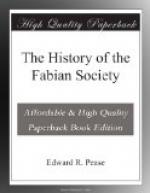In 1893 we find in “Seedtime” an Annual Report recording 12 public meetings, 4 social gatherings, a membership of 95, and receipts L73. During this year, 1892-3, J. Ramsay Macdonald, subsequently M.P. and Secretary and Chairman of the Labour Party, was Honorary Secretary, and for some years he was on the Executive. In 1896 the membership was 115 and the income L48.
The most persistent of the organisers of the New Fellowship was J.F. Oakeshott, who was also for many years a member of the Fabian Executive. Corrie Grant, later a well-known Liberal M.P., H.S. Salt of the Humanitarian League, Edward Carpenter, and his brother Captain Carpenter, Herbert Rix, assistant secretary of the Royal Society, Havelock Ellis, and, both before and after her marriage, Mrs. Havelock Ellis (who was Honorary Secretary for some years), are amongst the names which appear in the pages of “Seedtime,”
Mild attempts were made to carry out the Community idea by means of associated colonies (e.g. the members residing near each other) and a co-operative residence at 49 Doughty Street, Bloomsbury; but close association, especially of persons with the strong and independent opinions of the average socialist, promotes discord, and against this the high ideals of the New Fellowship proved no protection. Indeed it is a common experience that the higher the ideal the fiercer the hostilities of the idealists.
At Thornton Heath, near Croydon, the Fellowship conducted for some time a small printing business, and its concern for the right education for the young found expression in a Kindergarten. Later on an Ethical Church and a Boys’ Guild were established at Croydon.
Soon afterwards the Fellowship came to the conclusion that its work was done, the last number of “Seedtime” was published, and in 1898 the Society was dissolved.
[Illustration: From a photograph by G.C. Baresford, S.W.
HUBERT BLAND, IN 1902]
FOOTNOTES:
[7] Frank Podmore, M.A.—b. 1856, ed. Pembroke College, Oxford, 1st class in Science, 1st class clerk, G.P.O. Author of “Apparitions and Thought Transference,” 1894, “Modern Spiritualism,” 1902, “The Life of Robert Owen,” 1906, etc. D. 1910.
[8] Mr. Champion took no further part in the Fabian movement, so far as I am aware. His activities in connection with the Social Democratic Federation, the “Labour Elector,” etc., are not germane to the present subject. He has for twenty years resided in Melbourne.
[9] See complete set in the British Library of Political Science, London School of Economics.
Chapter III
The Early Days: 1884-6




